J H STEWARD LONDON ANTIQUE BRASS NEW BACTERIOLOGICAL MICROSCOPE WithWD CASE -C1903
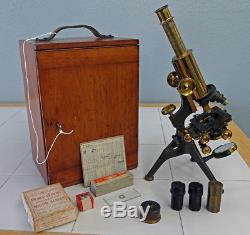
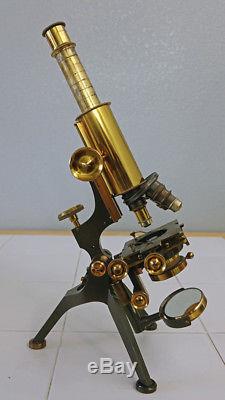
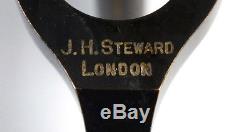

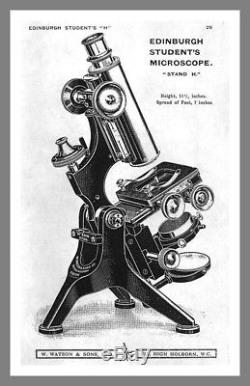

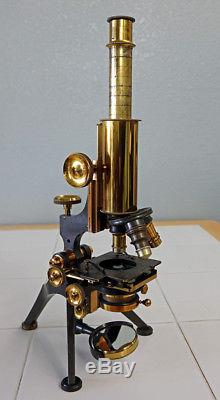
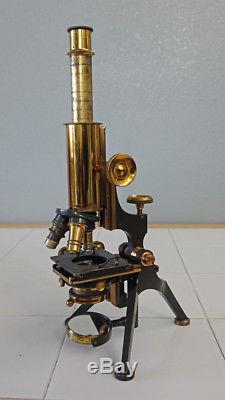



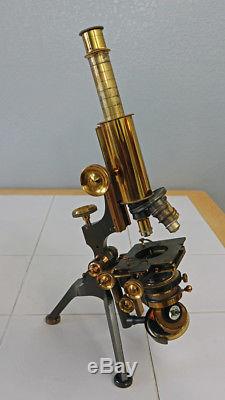

J H STEWARD LONDON ANTIQUE BRASS NEW BACTERIOLOGICAL MICROSCOPE W/WD CASE -C1903. J H STEWARD LONDON ANTIQUE BRASS NEW BACTERIOLOGICAL MICROSCOPE WITH ORIGINAL DOVETAILED MAHOGANY WOOD CASE & ACCESSORIES CIRCA 1903. This microscope includes a very nice mechanical stage, a very elaborate mechanical substage assembly along with a nice set of optical accessories. It also comes in its original dovetailed Mahogany wood cabinet with working lock and key. By viewing the accompanying images, astute antique microscope collectors will immediately recognize this microscope as a W.
Watson & Sons Edinburgh H Student stand rather than an original model microscope produced by J. This is due to the fact that Steward evidently had a private label merchandising agreement with Watson to produce microscopes for resale by his firm. Steward placed his name on the microscope and renamed it the New Bacteriological Microscope.
This was a common practice amongst microscope manufacturers and resellers of the day. Accompanying this listing is a copy of a catalogue cut of this microscope from Stewards 1903 Microscope Catalogue along with a catalogue cut of the Edinburgh H Student stand extracted from W. Catalogue of Microscopes that was published in 1921. By comparing these two catalogue cuts one can easily determine that both microscopes are in fact one in the same instrument.
Adding to this fact is that that the Steward instrument has two (2) objectives produced by W. Note: For more details on the history of the J. Steward optical firm, please see below.
This instrument is signed/engraved in block letters on the top rear of the tripod foot, J. STEWARD, LONDON (See close-up image that shows this). This microscope does not bear a typical serial number, so dating it is somewhat problematic. However, based on the appearance of this model in Stewards 1903 catalogue we can conservatively date the instrument to Circa 1903.
As the accompanying images will easily attest, this is a very nicely preserved early 20th Century brass microscope that will most certainly add luster to any antique microscope collection. Its very interesting origin and provenance from W. Watson & Sons will also be of special interest to antique microscope collectors. Dont miss this opportunity to add it your antique microscope collection. A heavy solid Japanned brass tripod base of monolithic construction rises to a trunnion joint that captures the limb and the rest of the instrument. The tripod foot spreads to a full 7 inches and so is very firm in any position.The trunnion joint allows the instrument to be adjusted to any angle from the vertical to the horizontal for the comfortable viewing of specimen slides or to facilitate microphotography. The instrument has a large fixed main stage with dovetail grooves on either side.
Sliding over the dovetail rails is a mechanical stage assembly that features dual milled heads that control both the x and y motions of the stage from the right side of the instrument. The stage plates themselves are so arranged that the top of the substage condenser is never fouled by the stage at any point in its travel. Scales and verniers for both the x and y axis are found under the stage plates so the user can return to exact positions on slides viewed under the microscope (See close-up images that show this). A pair of slide clips is found on top of the stage.
The limb of this instrument is of unitized construction and extends both above and below the trunnion joint. Below the joint and the fixed stage, the lower limb supports a substage illumination assembly that has angled rackwork along with focusing controls that allow it to be moved closer to or away from the stage. This assembly includes an Abbe condenser with centering scews and also includes an iris diaphragm that is operated with a lever that extends to the front of the unit. Also extending from the lower end of the limb is a cylindrical brass bar that accommodates a yoke mounted 50mm diameter brass mounted plano-concave mirror assembly on a sliding bar that provides illumination to the stage. The upper portion of the limb of the instrument supports the body tube as well as the rackwork and the coarse and fine focus mechanisms. The lacquered brass body tube of this instrument is a beefy 1.5 inches in diameter and includes a brass drawtube, which is engraved with seven (7) circular tube settings that are 10mm apart. In fact, they vary from 150 to 250mm A brass ocular holder is found at the top of the drawtube. A single 6x eyepiece marked with the letter B is included with the microscope.The lower end of the body tube is equipped with a triple position revolving objective nosepiece equipped with the following objectives: A Watson 2/3-Inch 0.28 N. Low power objective, a Watson 1/6 Inch 0.74 N. Medium power objective, and a Bausch & Lomb 97x 1.9mm 1.25NA Oil Immersion high power objective. Each of the objectives comes with a canister for storage of the objectives when not in use on the microscope. Coarse focus is by angled rack and pinion.
Fine focus is by means of a through-the-limb lever type system that was developed by W. A finely milled screw actuated by a brass micrometer knob atop the limb acts on a dual spring loaded lever with the fulcrum of the lever very close to the body tube resulting in very slow motion communicated to the body tube. The movement imparted by one complete turn of the milled head is only 1/300 of an inch, which is ideal for high-power bacteriological work for which this instrument was especially designed. When the optical tube is racked all the way in and the microscope stands vertical with the drawtube fully nested within the body tube, the height of the microscope is about 12.5 inches from the base of the tripod foot to the top of the eyepiece.
When the optical tube is racked all the way out and drawtube is fully extended all the way out, the microscope stands 16 inches tall making for a relatively tall microscope. The microscope weighs about 8 pounds. The following accessories accompany this microscope. A box of ½ gross of blank glass slides.
A box of square cover glasses. A custom made micrometer slide with an accompanying cardboard mounted diagram that defines the spacing of the inscribed lines on the slide. A brass aperture stop holder that can be used to replace the Abbe condenser on the microscope. Accompanying the microscope is a very nice dovetailed Mahogany wood cabinet with a leather carrying handle and a working lock with key.Inside the case is a wood rack that holds the brass aperture stop holder. The exterior dimensions of the wood case are 13.5 inches tall, 9 1/8 inches wide and 7.75 inches deep. The microscope in its wood case along with the included accessories weighs about 13 pounds. NOTE: The accompanying images are a part of this statement of condition.
Please take the time to view all of the accompanying images. They are designed to show the instrument at various angles. The instrument was photographed under natural light conditions. The images illustrate some of the salient features as noted in this description and will give you a good idea of what you will be getting should you be the proud new owner of this superb antique brass microscope. All in all this is a very well preserved example of Stewards New Bacteriological Microscope, which is in fact virtually the same instrument as a Watson Edinburgh Model H Student Microscope. In summary, it is in very good to excellent cosmetic, optical and mechanical condition.The brasswork on this instrument is in very good to excellent condition as is clearly evident from the accompanying images. I would estimate overall original lacquer retention to be very close to 100%. There is just one small area of tarnish at the base of the body tube. The Japanned black metal portions of the microscope are also in very good to excellent condition with virtually no evidence of any tarnish or other cosmetic defects. The only cosmetic treatment we have given this instrument was to clean it of dirt and grime with dilute Windex and then to give it a protective coating of Renaissance Wax from THE GEMMARY to preserve it.
NOTE: WE MAKE IT A FIRM PRACTICE NOT TO DEEP CLEAN AND POLISH ANTIQUE BRASS MICROSCOPES. The optical elements that come with this microscope including the eyepiece, objective lenses and the Abbe condenser are all in excellent condition with no evidence of fogging, fungus, delamination or other defects. The plano-concave mirror is in excellent condition.
Mechanically, both the coarse and fine focus mechanisms work smoothly and flawlessly. The stage operation is very good, with both the x and y movements being smooth without any binding.In addition, the rack and pinion focus mechanism associated with the substage illumination assembly works smoothly. The iris diaphragm also works smoothly and there is no tarnish or rust on the iris blades.
The Mahogany wood case that houses this microscope is in very good serviceable condition and is structurally sound. It is the original Mahogany case for the microscope and even includes a working lock with key. Typical of virtually all antique wood microscope cases, this case has some surface scratches and dings both inside and outside from use over the years. There is also a minor age crack in the back of the case.
This antique brass microscope with case will most certainly be a highly prized addition to any microscope collection. In fact, it still is fully functional and, if desired, can still be used to this day for serious microscopic investigations that include microphotography, if desired. However, as time passed, the business grew to include telescopes, binoculars, compasses, barometers, and microscopes. This was first and foremost a family owned business that was passed on solely through the male line.As his sons joined the business, each was charged with operating a satellite store within the London area. Steward held patents relating to binoculars, telescopes, and aneroid barometers but no microscope-related patents.
In the mid-1800s, Steward became the optician to Her Majestys Government along with the National Rifle Associations of England, Canada, India and the other British Colonies and with the British National Artillery Association. For example, his 1903 Catalogue of Microscope featured microscopes made by Watson & Sons, including Watsons Fram microscope, which the company renamed the Students Five Guinea Microscope and Watsons Edinburgh H Student stand, which the company renamed The New Bacteriological Microscope, along with several imported instruments from France.
Relative to microscope sales, Steward was perhaps best known for his production of his Folding Pocket Microscope that was featured in both his 1880 and 1903 Catalogues. After the senior Steward died in 1896, his sons carried on the business on into the 20th Century.
On February 1, 1913, the business was incorporated as J. A new and updated Catalogue of scientific instruments appeared in 1923.Over the years the business was carried on from the following multiple locations. 1856 1971: 406 The Strand.
1866 - +/-1893: 54 Cornhill, London E. 1867 - +/-1930: 63 St. 1869 - +/-1930: 66 The Strand, London W. 1886 1928: 457 West Strand, London W.1893 - +/-1905: 7 Grace Church Street, London E. 1971 1973: Catherine Street, London W. 1973 1975: 154 Church Road, Hove, Sussex. Goble, a dispensing optician, was now the only member of the staff running the shop. He was mainly retained by the family to provide a service to long-standing customers and to reduce the stock levels.
Then, in 1973, the remaining instrument part of the business finally moved out of London to Hove, Sussex. In 1975, despite the efforts of the founders great-grandson and his wife, the business closed its doors for the last time thus ending a longstanding London based optical business that lasted more than a century. THE MONTANA LOGGER is very pleased to offer this superb antique brass J.We will also entertain your best offers for this fine instrument. FREE scheduling, supersized images and templates. Make your listings stand out with FREE Vendio custom templates! Over 100,000,000 served. Get FREE counters from Vendio today!
The item "J H STEWARD LONDON ANTIQUE BRASS NEW BACTERIOLOGICAL MICROSCOPE WithWD CASE -C1903" is in sale since Friday, December 14, 2018. This item is in the category "Collectibles\Science & Medicine (1930-Now)\Scientific Instruments\Microscopes, Lab Equipment".The seller is "mtloggera" and is located in Hamilton, Montana. This item can be shipped worldwide.
- Antique Brass Microscope: New Bacteriological Microscope
- Country of Manufacture: London, England
- Manufacturer: W.
Watson & Sons for J. Steward
- Product Type: Microscopes, Lab Equipment
- Country/Region of Manufacture: United Kingdom

